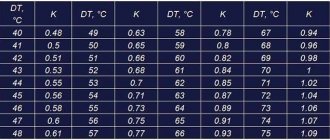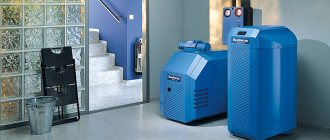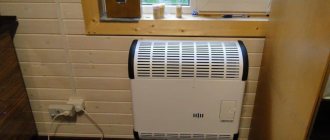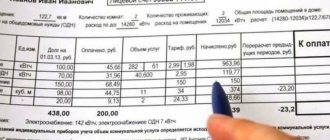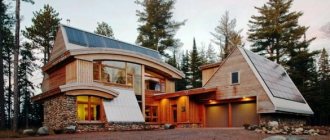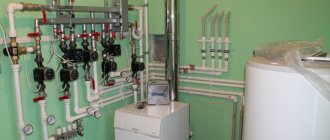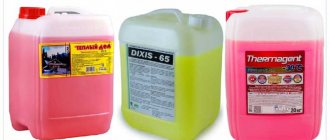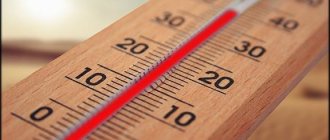In this article we will tell you everything you need to know about saving heat:
- Saving heat in a private home
- How to save heat in an apartment
- Saving heat in an apartment building
- Reducing thermal energy consumption in schools and kindergartens
- Heat saving at the enterprise
- How to save heat in the office
How to save heat in a private home
Correct orientation of the house to the cardinal points
When designing the house, the movement of the sun in winter and summer was taken into account.
In winter, maximum light enters the premises, but in summer, the sun’s rays practically do not penetrate into the house. Even at the stage of planning the site and choosing a project, it is worth taking into account the orientation of the house to the cardinal points. A thoughtful location will help protect against cold winds, drafts and let maximum sunlight into the house. You also need to take the wind rose into account. On average across Russia, western, northern and northwestern winds blow most often and are usually cold and gusty. Therefore, it is better to make walls oriented towards these sides either blank or with a minimum number of windows.
As for the layout, in this part of the house there will be technical and utility rooms - a storage room, a boiler room, storage areas, a garage, etc. They do not need special heating or natural lighting, and besides, they will serve to protect living rooms from drafts. The sunny southern side is considered the warmest, so large windows are the best place here. In addition, it is ideal for general gathering areas for family and guests (living room, dining room, etc.).
It is logical that in the southern regions, where the issue of saving on air conditioning is more pressing, the opposite principle applies: the facade with large-format windows is “turned” to the north to prevent overheating of the premises in hot weather. On the south side, they try to minimize the glazing area.
Glazing acts as a passive solar heating system. Therefore, by correctly positioning the building on the site, you can reduce heating costs
2
How to reduce heating costs and increase efficiency
Want to know how to make cheap heating? To do this, it is not enough just to buy an economical electric heater and install it in the house; you need to properly insulate the building. Significant heat loss from the room through the building envelope can cause you to be disappointed in its performance after purchasing the most efficient and economical electric heater.
Any gaps, cracks or holes in the flow or around windows and doors will help the room cool down quickly. Also, the reason for this may lie in leaky windows or in the absence of insulation in the wall structure. With high-quality insulation of the house, the heating efficiency indicator reaches 80%.
Be sure to install automatic heating control systems. So, if there is no one in the house during the day, it is better to configure the equipment so that it automatically turns on for heating a couple of hours before your arrival. As a result, you will walk into a warm home, but at the same time save on heating costs.
It is equally important to correctly calculate the power of heating equipment and select suitable locations for their installation. Be sure to install a two-tariff meter and configure the devices so that they operate at full capacity at night, when electricity is cheapest
House shape
The microclimate and energy efficiency of the cottage are not least influenced by the space-planning solution. It is based on the rule of compactness. Ideally, the house should be shaped in such a way that the ratio of its perimeter to the heated volume or area is as small as possible.
Tall buildings with a narrow body and large wall area are characterized by excessive heat loss. While low and wide houses, characterized by rational compactness, have a more stable microclimate and are less susceptible to wind.
It is also possible to save a little due to the optimal geometry of the house. If you abandon protruding architectural structures (bay windows, projections, etc.), the thermal efficiency of your home will increase. According to the Moscow Research and Design Institute of Typology, the heating costs of a building with a flat facade can be 10-12% lower compared to the construction of a complex configuration.
There are interesting calculations confirming how the shape of a house affects heat savings. The data applies to high-rise buildings, but may well be applied to private buildings. For example, atrium-type buildings can reduce heat loss by up to 35% compared to standard ones.
A house with a simple cubic shape loses much less heat than a building of similar volume with a complex wall configuration
3
We save heat at the enterprise
You can save heat in enterprises in the following ways.
- The use of heat-saving polyvinyl chloride film, which is mounted in the interframe space of the windows. These are so-called energy efficient windows.
- The use of canvas curtains at the entrances to production premises and workshops.
- Glazing of industrial premises.
- Enterprise heating inspection
- Calculation of thermal loads
In addition, it is necessary to take the measures described above, that is, glazing the premises, insulating the walls, eliminating cracks in the windows, etc.
Save heat in the office
Presence of a vestibule
The vestibule serves as a thermal gateway between the street and the living rooms. This room, which in ancient times was always present in Russian huts, is extremely rare in modern projects. But in vain, since winter in Russia is still harsh, and protection against the penetration of cold air into the house will obviously not be superfluous. The hallway, usually adjacent to the living room or dining room, without a vestibule, is very cool. As a result, heat loss is very significant. A veranda or garage can also play the role of a thermal buffer.
In summer, the vestibule is no less useful than in winter - in the heat it keeps the rooms cool
4
Is it profitable to install roller shutters?
In fact, roller shutters are a modernized version of the traditional wooden shutters for our country, which used to be on every window in every house. In the summer they helped keep things cool, in the winter they helped keep them warm, and when the residents were away they protected them from dishonest people. In the current, high-tech version, roller shutters come in two types:
Burglar-resistant - made from extruded profiles, which, due to their larger wall thickness and the presence of stiffeners, are characterized by increased resistance to mechanical stress. Such roller shutters are most often installed at public facilities where maximum security is needed.
Energy efficient - made from roller rolled profiles. Thanks to the dense foam inside the profile, excellent heat-saving and sound-proofing properties of the structure are ensured. If the house is located near a noisy road, energy-efficient roller shutters will not only reduce heat loss through the windows, but will also contribute to a comfortable acoustic environment.
However, FORUMHOUSE users have a reasonable question: what actually reduces heat loss - due to the air cushion between the roller shutter and the window or due to the foam inside the profiles?
fgor09FORUMHOUSE Member
I don’t understand, energy efficient roller shutters, not empty inside, but with insulation (foam), profanity? So it's not worth overpaying for them? What kind of roller shutters are needed to insulate windows then?
Stanislav KuzmitskyDeputy Marketing Director
There are several options for covering profiles, including those with foam filling. Heat conservation is ensured by a closed loop and the creation of an additional air gap between the window unit and the roller shutter. But the efficiency of roller shutters made from foam-filled profiles is still higher.
To confirm their thermal efficiency, a set of tests was carried out in one of the most prestigious International research institutes - ift Rosenheim (Germany) according to the methods of the main European standards in this field. The results showed that a window (single-chamber double-glazed window) without roller shutters and without additional insulation has a thermal conductivity coefficient of 1.9. The installed roller shutter allowed us to reduce the coefficient to 1.3. This means that heat loss through windows is reduced by up to 30%! This indicator takes into account the thermal resistance of both the roller shutter itself and the air gap formed between the window and the roller shutter in the closed position.
But given that energy-efficient roller shutters only work when they are closed, private home owners are also concerned whether trying to save money will backfire.
gomis75FORUMHOUSE Member
The more I delve into it, the less I see the obvious advantages of roller shutters.
- When the roller shutters are completely closed, in the absence of the owners, protection is provided against objects thrown through the window or thieves - a definite plus.
- In summer, not fully closed roller shutters protect from direct sunlight - a plus. While completely enclosed structures are a minus, since you need to use artificial lighting, and this is an expense.
- Energy saving with fully closed roller shutters is only at night, otherwise there will be expenses for artificial lighting, and this is a minus.
- There are no security characteristics (GOST - 2 minutes to break into extruded fabric with a hand tool “without noise and dust”). This is a minus.
- A possible reduction in the cost of the insurance policy if there are roller shutters is not an obvious plus.
Stanislav KuzmitskyDeputy Marketing Director
- To protect the room from heating, it is enough to block direct sunlight and it is better to do this outside the room (so that the elements that heat up from the sun are outside and do not begin to heat everything inside themselves - this is a plus of roller shutters, unlike the same curtains). On a weekday in the summer there is usually no one at home, but if there is someone at home, blocking the direct rays is enough.
- In winter, during daylight hours, it is better to open the roller shutters so that the rooms are heated by the sun. And as soon as it goes away and it gets colder, close it. By the way, this is the advantage of roller shutters, in contrast to the same films on windows, which will block sunlight even in winter, preventing the room from warming up.
- Energy-efficient roller shutters are only one element of a home security system, and 2 minutes is almost half of the regulated police arrival time (in case of an alarm, it’s about 5 minutes). In addition, it is worth taking into account the psychological factor: often a thief can refuse to steal where penetration will require additional effort, and without knowing in advance what obstacles there may be behind the canvas.
- Insurance is rather a nice bonus.
To everything else, we can add that in winter it gets dark outside the window already at five o’clock, and in some regions even earlier - you have to turn on the lights. But if there are roller shutters, there will be no heat outflow through the windows for most of the day, and on a sunny day you can also turn down the heating in the rooms.
What do experts say about the economic feasibility of installing roller shutters? How quickly will they pay for themselves?
Stanislav KuzmitskyDeputy Marketing Director
The approximate payback period (according to calculations we carried out about 2-3 years ago) was 5-7 years. But everything very much depends on the region and the cost of energy resources. For example, in the EU this period may be 2-3 years. For convenience, we have made a calculator (with a number of simplifications and assumptions) that will allow you to calculate approximate savings.
Warm doors
Door design option with thermal break
If a vestibule is not provided in the house, double doors can serve as a thermal buffer. However, such designs are not always convenient and are also difficult to install. An excellent alternative to them would be a warm door or, as it is also called, a door with a thermal break. Its main difference from the usual one is several layers of thermal insulation, which are designed to keep the cold out and keep the heat out.
Some manufacturers increase the number of layers to seven or even more. Extruded polystyrene foam, stone and glass wool, and polyurethane foam are used as thermal insulation.
Its second feature is an insulating layer (usually polyamide), which separates the insulation from metal surfaces, preventing heat transfer between materials. This is what is called thermal break.
Finally, the steel frame (steel thickness at least 2 mm) is the most important structural element of a door with a thermal break.
An ordinary metal door reliably protects against uninvited guests, but not against winter frosts. The so-called warm doors, according to manufacturers, do not freeze even in the most severe cold
5
Heating methods and their efficiency
Traditionally, autonomous heating systems are used to heat private houses. The energy sources for their operation are natural gas, liquefied gas, solid fuel, liquid fuel and electricity. Systems running on natural gas are considered the most economical. But in some conditions their efficiency does not play any role. For example, if the house is not connected to the gas main, then comparisons with gas are not appropriate.
Gas heating systems
Economical heating systems for a private home are systems that run on cheap coolant. If there is a gas main nearby, feel free to connect to it and use one of the most inexpensive sources of energy. Comparing gas costs with costs for other sources, you begin to understand that this is one of the most inexpensive types of fuel.
In the absence of a gas main, liquefied gas is often used, supplied in cylinders or stored in gas tanks. But this option cannot be called the most economical, although it is very simple in its implementation - just purchase a regular gas boiler and reconfigure it to work with liquefied gas.
Solid fuel heating systems
Economical heating of a private house without gas can be built using a solid fuel boiler. To power it, coal, coke, briquetted fuel and even ordinary firewood are used. Coal burns the longest, but it is also quite expensive. But the heating system is not only economical, but also inexpensive - the simplest solid fuel boiler is quite affordable.
The cheapest heating of a private house without gas is built using solid fuel boilers, sometimes homemade ones. If you want to ensure more convenient operation of the system, you should take a closer look at a boiler with a small bunker for pellet fuel (fuel granules). Such pellet boilers operate automatically, requiring only periodic loading of new portions of pellets.
The operation of solid fuel boilers using wood is complicated by the need to load firewood too often. In addition, you need a lot of firewood, which increases the cost of operating the heating system. As soon as you miss the moment of loading the next portion of fuel, the house will begin to become cooler. The problem is solved by installing special long-burning solid fuel boilers.
It should be noted that heating systems powered by wood can be economical, even completely free - you can chop firewood in the forest yourself, which is used by people living in small settlements.
Liquid heating systems
Liquid fuel heating systems cannot be called the most economical. After gas and solid fuel they occupy an honorable third place. Used engine oil and diesel fuel are used as fuel. Because of this, in houses heated by liquid boilers, there is always a characteristic smell. There is also a need to create a special storage facility for liquid fuel, and at a distance from residential buildings - this creates additional costs.
Electric heating systems
It is difficult to create cheap heating of a private house with electricity - you need a source of free electricity. The thing is that classic electric boilers are unusually voracious. And it is almost impossible to do anything here, since their efficiency is 99% - that is, almost all the energy is converted into heat. Induction boilers can provide some efficiency, but many experts are not ready to confirm this fact.
Economical electric boilers for heating a private home exist, but they are much more expensive than their simple, small-sized counterparts. Savings are achieved through the use of weather-dependent automation and room temperature sensors. That is, they are able to automatically adapt to the characteristics of outdoor and indoor temperature conditions, adjusting the heating power - if a person were to make the adjustments, the costs would be higher.
The disadvantages of electrical systems are the need for good electrical wiring and the presence of a three-phase network to power the most powerful models of boilers.
Sealed thermal insulation circuit
Significant heat loss from a building occurs through the foundation, walls and roof. The statistics are not at all cheerful: about 15% of the cottage’s thermal energy is lost through the foundation and floor, about 20% through the walls, and about 15% through the roof. Therefore, the main preventive measure against heat leaks is the creation of a sealed shell that does not have cold bridges.
Even at the stage of digging a pit, it is necessary to form a continuous heat-insulating circuit that excludes contact of the foundation with the ground.
There are two ways to achieve high heat-saving ability of walls. The first is to build structures from traditional “cold” materials (reinforced concrete, foam concrete, brick, etc.), increasing their thickness. However, this option is not economically viable, since you will have to overpay for materials for both the walls and the foundation. In addition, labor costs will increase.
A more reasonable way is to build enclosing structures of optimal thickness from materials that have a low thermal conductivity coefficient. These are either single-layer walls made of large-format porous ceramic bricks or aerated concrete blocks, or multi-layer walls with effective thermal insulation (layered masonry, external insulation with a plaster layer and a ventilated facade).
The advantages of single-layer structures are the acceleration of construction processes, as well as the ability to abandon thermal insulation. The advantage of multilayer ones is the insulation installed on the street side - it covers possible cold bridges, and in addition protects the walls from external influences and temperature fluctuations.
Frame wall design with cross insulation and various cladding
6
Saving water
- Install water flow meters. This will motivate you to reduce water consumption.
- Install lever switches on faucets instead of rotary faucets. Water savings of 10-15% plus ease of temperature selection.
- Do not turn on the water at full blast. In 90% of cases, a small jet is sufficient. Savings 4-5 times.
- When washing and showering, turn off the water when it is not needed.
- Taking a shower uses 10-20 times less water than taking a bath.
- Significant water savings will be achieved by using two-button flush tanks.
- It is necessary to carefully check for water leakage from the cistern, which occurs due to old fittings in the cistern. Replacing fittings is a cheap task, but the water savings are impressive. Through a trickle of leakage, you can lose several cubic meters of water per month.
- Check how the return flow to the hot water supply works. If there is no circulation during supply, then you will be forced to pump water through your neighbors' risers until you get it hot in your apartment. Of course, in this case, expensive “hot” water is simply drained into the sewer.
Site visitor additionally recommends: (thank you!)
Savings in the bathroom
- Don't leave the tap running all the time while brushing your teeth. Try to turn it on at the beginning and end of the procedure. You might even buy some mouthwash. This will allow you to use the money you save to protect the health of your teeth. Savings: 15 liters of water per minute (757 liters per week) with 4 family members.
- Turn off the tap while shaving. A small bowl will help you rinse your razor and save you money. Savings per person: 380 liters per week.
- Reduce your shower time to 5-7 minutes. Savings per person: from 20 liters of water with each shower.
- When taking a shower, it is not necessary to leave the water flow at maximum all the time. Use maximum pressure when rinsing and rinsing off foam. Savings per person: up to 20 liters of water with each shower.
- Fill the bath 50 - 60%. Savings per person: up to 20 liters of water with each bath.
Savings in the kitchen:
- When washing dishes by hand, fill one of the sinks (or another container) with water mixed with detergent. Then rinse the dishes treated with detergent in another sink under low pressure of warm water. Savings per person: up to 60 liters of water per day.
- Use the dishwasher with a full load whenever possible. Savings per person: up to 60 liters of water per use.
- Wash fruits and vegetables in a sink filled with water with the tap turned off. Savings per person: up to 10 liters of water per day.
- Do not use water to defrost meat products. You can defrost them by leaving them in the refrigerator overnight. Savings per person: up to 10 liters of water per day.
In general, reducing water consumption by 4 times is a completely feasible and low-cost task.
Additional cross-roof insulation
Design of an attic roof with cross insulation
As for the roof, its heat-saving ability can be improved by creating an additional cross-circuit insulation of the structure. In central Russia, the thickness of fiber insulation for an attic roof should be 200 mm. Meanwhile, the standard height of wooden rafter beams is 150 mm, and therefore many developers install a thermal insulation layer also 150 mm thick.
Naturally, there is no need to talk about the energy efficiency of such roofs. This raises a number of other problems. Firstly, the wooden rafter leg is, to a certain extent, a cold bridge. So, if the roof is insulated only with slabs or mats laid between the rafters, freezing of this structure cannot be avoided.
Secondly, even experienced roofers, when installing slabs or mats, cannot achieve an absolutely tight fit to the rafters along the entire slope; leaks will certainly remain somewhere and cold bridges will appear. This is especially true for roofs of complex shapes, where the insulation has to be trimmed to fit it between the rafters. It turns out that only an additional cross-circuit insulation can provide the required thickness of the thermal insulation layer and cover possible cold bridges.
Additional costs for thermal insulation of a house pay off, as a rule, within two to three years
7
Energy saving technologies and alternative heating systems
Layout of elements
Maximum savings in energy sources when heating a country house can only be achieved if it is possible to maintain low temperature conditions in the heating system for a long time. Energy-saving technologies make it possible to achieve high efficiency levels with low fuel consumption.
Warm floors are considered the best option for heating residential premises in a country house. Thanks to their design, such systems quickly, evenly and efficiently heat rooms at relatively low coolant temperatures. Distributing pipes or cables over the entire floor area prevents heat loss and promotes optimal heat distribution over height. In this case, at the level of the feet the temperature is higher than at the level of the head.
No radiator model can provide uniform heating of the room - it will always be warmer near the radiator than at a distance from it.
Visual view
In private homes, from an economical point of view, the following have proven to be excellent:
- infrared systems that do not require laying pipes or installing boilers;
- skirting systems located around the entire perimeter of the floor;
- air systems that pump heated masses into the room and suck cooled ones back into the unit.
For private homes, solar or geothermal heating can be considered as alternative heat sources. Such systems are completely autonomous, but expensive. After a few years, they, of course, pay for themselves and begin to make a profit in the form of savings on utility bills.
Warm windows
Energy-saving windows with low-emissivity coating
The wrong choice of window and installation errors can lead to the fact that you will have to “go down the drain” paying heating bills. In total, approximately 35% of the cottage’s heat leaks through the windows (over ⅔ of the heat through the glass, and the rest through other structural elements). For energy-efficient houses, it is recommended to use windows with wooden frames and double-glazed windows or structures made of “warm” aluminum. PVC profiles are subject to serious deformation due to temperature changes. The wider the profile, the better it protects from the cold. As for prices, for comparison, we note that wooden windows cost from 7,100 rubles/m², plastic ones with the same characteristics - from 4,600 rubles/m², systems made of “warm” aluminum will cost 4,300–4,700 rubles/m².
The heat transfer resistance of glazing is also increased by a low-emissivity optical coating - hard (k) made of thin-layer metal oxide and soft (i) made of metal oxides. The latter are unrivaled in terms of energy saving: heat loss through the window structure is reduced by 90%. Application of a low-emissivity coating increases the cost of a double-glazed window by 20-30%.
Even if the house was built without taking into account the above recommendations, it is worth changing the windows, and monthly payments will significantly decrease
Poison the air!
Air pockets can form in radiators and heated floors over time. They impair the efficiency of the heating system and increase the consumption of gas, electricity and other energy carriers.
Immediately after starting the heating system, check how efficiently it works. Try bleeding air from radiators or heated floors. Read more about that. Read how to do this in the articles “How to remove air from a warm water floor” and “How to properly bleed air from a heating radiator.”
If you have radiator heating, do not forget to check it at least once a month. Pay attention to how efficiently radiators heat. is there a temperature difference in their lower and upper parts.
